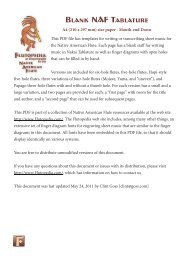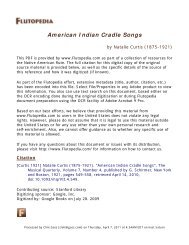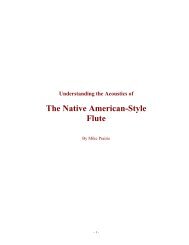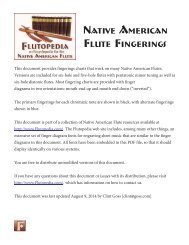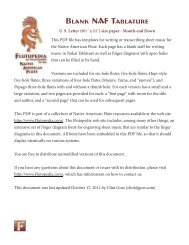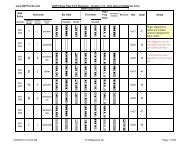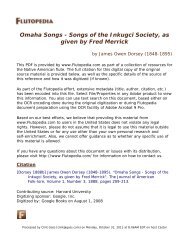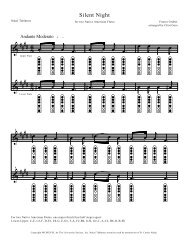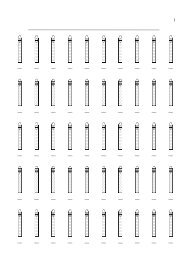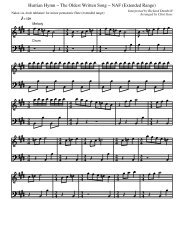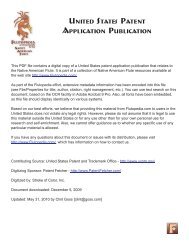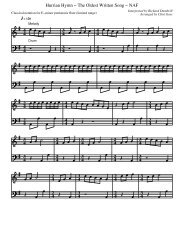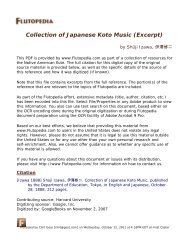Music of Acoma, Isleta, Cochiti, and Zuñi Pueblos - Flutopedia.com
Music of Acoma, Isleta, Cochiti, and Zuñi Pueblos - Flutopedia.com
Music of Acoma, Isleta, Cochiti, and Zuñi Pueblos - Flutopedia.com
You also want an ePaper? Increase the reach of your titles
YUMPU automatically turns print PDFs into web optimized ePapers that Google loves.
irr^[Irirr<br />
[mMhnr:^<br />
PErp<br />
'<br />
72 BUREAU OF AMERICAN ETHNOLOGY [BttlI/. 165<br />
Analysis.—The form <strong>of</strong> this song resembles that <strong>of</strong> the corn-grinding songs in<br />
its periods <strong>and</strong> their repetition, but differs in that it contains two instead <strong>of</strong> three<br />
periods <strong>and</strong> the keynote is the lowest as well as the final tone. Attention is<br />
directed to the repetition <strong>of</strong> the rhythmic unit in period B on tones a fourth lower<br />
than in period A. This is the more interesting as both periods are based on the<br />
triad above the keynote. Thirteen <strong>of</strong> the 65 intervals are fourths <strong>and</strong> more than<br />
half are whole tones. The rhythmic unit is a detached phrase, having no influence<br />
on the rhythm <strong>of</strong> the song as a whole. The pitch at the close <strong>of</strong> period A was<br />
a semitone lower than at the beginning. This lowering <strong>of</strong> pitch was not gradual.<br />
The tone transcribed as E-flat at the end <strong>of</strong> the period was sung a semitone lower<br />
than the indicated pitch <strong>and</strong> in the succeeding measures it was slightly raised,<br />
though returning to the lower pitch at the close <strong>of</strong> the song. The singer recorded<br />
a repetition <strong>of</strong> this song after a short pause. This repetition began on D <strong>and</strong> sank<br />
to D-flat by the end <strong>of</strong> the first period, ending on the lower pitch. The measures<br />
in 3-8 time were uniform in the two renditions.<br />
It was said that the next song is an old melody to which new words<br />
could be added if desired.<br />
(Catalog No. 1997)<br />
No. 49. War song (b)<br />
V' i\\ 'i<br />
QT+rC/<br />
!!•<br />
^I<br />
'^<br />
I<br />
££<br />
i !» 0? » • # 3:<br />
mi^rCrifft^mL::pv<br />
i<br />
rTrTi;|l^te<br />
^k<br />
i<br />
PCrMi rrPv^i^''-T^.Tiii^trp<br />
PD7s<br />
'^mr[rr<br />
i<br />
n^f[^y<br />
\<br />
IT<br />
\V2~G<br />
i<br />
\<br />
9.!<br />
p^p[p<br />
;<br />
^M<br />
^m„ f-p^<br />
^m !UI<br />
\<br />
li^^P i<br />
iirrp^Pirrrcm<br />
'i ^mW^\ia^^^



